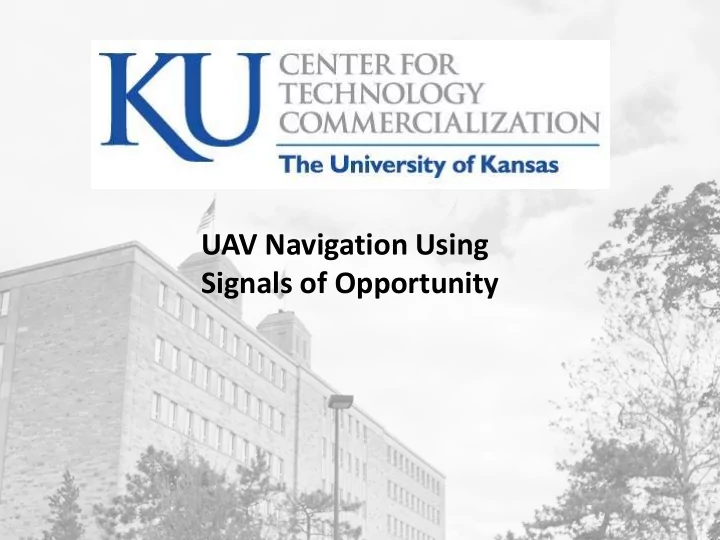

UAV Navigation Using Signals of Opportunity
OPPORTUNITY • PROBLEM – GPS signals are weak; can be broken, jammed, or spoofed • SOLUTION – Use existing commercial broadcast signals to augment GPS • PRODUCT – Low power, light-weight radio + signal analysis
MARKET • Government – Military, first responders, aerial surveillance • Commercial – Amazon, Google, others investigating use of UAVs • Agricultural/Industrial – Crop maintenance/inspection http://smallbiztrends.com/ • VC investment, global UAV market show continuous growth • North America, Europe expected to hold 67% market share
TECHNOLOGY • Competing devices to combat signal loss: – Inertial systems • Susceptible to accumulated error • Greater accuracy = greater cost – Ground-based reference stations • Requires infrastructure (costly) • KU Invention: – Calculates position based on signals received in miniature RF receivers – Makes use of transmitter database • Maintained by FCC in US
FEATURES AND BENEFITS FEATURES • Low power requirements • Low weight/size – High performance RF circuitry • Accuracy sufficient to supplement GPS BENEFITS • Protection from lost signals, jamming, spoofing – Prevents flyaway, hijacking • Provides a check for GPS accuracy • Designed for assembly from commercially available components
VALUE PROPOSITION Prevents loss of aircraft and collateral damage associated with: Spoofing Jamming http://www.ainonline.com/ http://www.csmonitor.com/ • Military UAVs present safety, national security risk if GPS fails • Civil UAV testing requires FAA approval of control systems – Backup system for GPS reduces safety risk • System is adaptable to other types of vehicles (e.g., ground or water- based) or other types of signals (e.g., WiFi, acoustic, or optical)
NEXT STEPS • Additional Product Development/Testing – Computer simulation has been partially verified by ground-based testing using FM broadcast signals – In-flight testing will require trained personnel to: • assemble and install hardware on aircraft • collect and process the data • Build Industry Involvement – KUCTC marketing campaign underway to identify companies capable of further development
CONTACT INFORMATION • David Richart, JD Licensing Associate KU Center for Technology Commercialization University of Kansas drichart@ku.edu (785) 864-0124
Recommend
More recommend